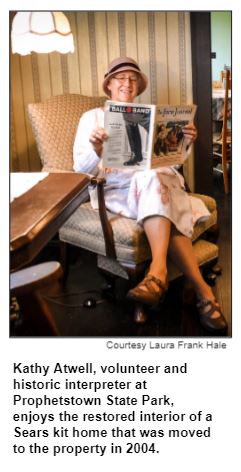May 1, 2020
Although Sears Roebuck & Co. announced many department store closings across Indiana and filed for Chapter 11 bankruptcy in 2018, the retailer has a deep and storied history on many levels in the Hoosier state. In this encore show originally broadcast in November 2018, we turn back the pages of history to explore the enormous impact of the Sears Roebuck Catalog 100 years ago, particularly on small towns and rural areas.
In addition to leafing through the catalog's significance in its heyday (with more than 500 pages, it has been called "the amazon.com of its era" by social historians), we also explore Sears kit homes that were built across Indiana beginning in 1908.
The mail-order catalog began earlier, during the 1890s, and offered products ranging from household appliances to hats, shoes, undergarments, sleds, dolls and baseball mitts from Sears. Rival retailer Montgomery Ward had been selling goods by mail even before that, having been established in 1872.
Nelson's studio guests are Paul Diebold of Indiana DNR's division of historic preservation and archaeology, an expert on Sears kit homes, and public historian Glory-June Greiff, who has researched the impact of the catalog.

Eventually, she adds, the catalogs even resulted in a clamor for improvements to county roads, "especially farm-to-market roads so that rural dwellers could more easily pick up their catalog orders. No RFD [Rural Free Delivery] then." In fact, the popularity of catalog-ordering was a major factor in establishing RFD.
Although the most prevalent Sears kit homes were bungalows and cottages, the ready-to-assemble houses came in dozens of styles. Aspiring homeowners were sent lumber and other supplies along with an 80-page instructional booklet, Paul Diebold notes.
At The Farm at Prophetstown in Prophetstown State Park in Tippecanoe County, there's even a replica of a Sears kit farmhouse as well as a restored kit home that was moved from nearby Lafayette.
 The kit homes
- Sears preferred the phrases "Sears Modern Home" or "Sears Catalog
Home" - were available for order for 32 years, ending in 1940. The
kit homes were particularly popular in cities like Indianapolis
that had direct railroad connections with Chicago-based Sears, Paul
says.
The kit homes
- Sears preferred the phrases "Sears Modern Home" or "Sears Catalog
Home" - were available for order for 32 years, ending in 1940. The
kit homes were particularly popular in cities like Indianapolis
that had direct railroad connections with Chicago-based Sears, Paul
says.
By 1915, when Sears opened its first retail store in Chicago, the catalog and kit homes had become iconic. According to news accounts about the bankruptcy, at its retailing peak Sears had 4,000 department stores across the country,
 The closings announced
in 2018 included Sears stores in Greenwood and Terre Haute. Sears
had been an anchor of the Greenwood Park
Mall since the regional shopping center opened in
1966. A wave of closings announced earlier in 2018 included the
store at Castleton Square
Mall, the only remaining Sears department store in
Indianapolis.
The closings announced
in 2018 included Sears stores in Greenwood and Terre Haute. Sears
had been an anchor of the Greenwood Park
Mall since the regional shopping center opened in
1966. A wave of closings announced earlier in 2018 included the
store at Castleton Square
Mall, the only remaining Sears department store in
Indianapolis.
Sears began as a watchmaking company in the 1880s. Like Sears, Montgomery Ward was based out of Chicago; it initially sold goods exclusively by mail. During our show, Glory-June discusses retail options that were available to rural dwellers before Ward and Sears -- and "how the catalog companies changed all that."
According to the New York Times, some editions of the Sears Roebuck catalog "would fatten to more than 1,000 pages" during the early 1900s.
"It educated millions of shoppers about mail-order procedures such as shipping, cash payment, substitutions and returns," according to an article published on the Smithsonian website. "It used simple language and a warm, welcoming tone."